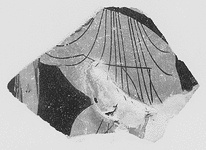Agora Object: Agora XXX, no. 1673 | Chronology: | | Probably early 5th century B.C. | | Deposit: | | F 19:5 | | Published Number: | | AV 30.1673 | | References: | | Object: P 15921
|
Wall fragment from the receptacle of a rhyton(?). Max. dim. 0.063.
Maenad (most of draped legs, hanging leg of her nebris), probably dancing to right. Above her right thigh at the break is a bit of reserve that is very likely part of her extended forearm. Overlapping her left leg is a horn in added clay and, around it, the fingermarks of the potter where he smoothed the clay. Preliminary sketch. Relief contour. Dilute glaze: nebris.
1673, with the bovine horn in added clay, probably comes from a rhyton, but so little remains that it did not seem to warrant a separate category. It is difficult to find a good parallel among similar rhyta.
During his visit to the Agora in the summer of 1953, Beazley suggested that 1673 is a fragment of a plastic vase, presumably a rhyton. The shape of the horn is that of a cow, but cow-head rhyta known to me are quite different and considerably later than 1673: Paris, Petit Palais 371 (ARV2 777, ---, 1) and New York, M.M.A. 06.1021.203 (ARV2 777, ---, 2; Paralip. 417, 2; H. Hoffmann, Attic Red-Figured Rhyta, Mainz 1962, pl. 13), both from the Cow-Head Group; Naples Stg. 62 by the Eretria Painter (ARV2 1251, 37; Lezzi-Hafter, Eretria-Maler, p. 348, cat. no. 258, pl. 170); Boston, M.F.A. 01.8105 (ARV2 1551, 11; Hoffmannn, pl. 19:1, 2); and Ruvo, Jatta 1116 (ARV2 1551, 12) from the Group of Class W to which Hoffmann assigns a third, Bayonne 118 (p. 42, cat. no. 112, pl. 22:1) but which Beazley (ARV2 1704) places near the Group. None of these has the horn in relief attached to the receptacle. Instead it is three dimensional. For rhyta, see Lezzi-Hafter, Eretria-Maler, pp. 263--276; also H. Hoffmann, "Rhyta and Kantharoi in Greek Ritual," Greek Vases in the J. Paul Getty Museum 4 [OPA 5], pp. 131--166. I have not seen the Harvard dissertation by Marion True: "Pre-Sotadean Red-Figure Statuette Vases and Related Vases with Relief Decoration" (cited by Hoffmann, p. 134, note 27).
|
